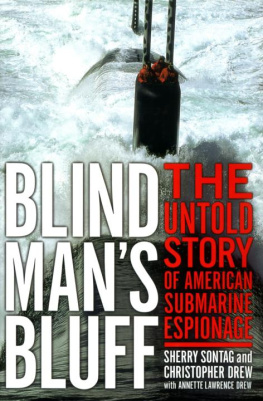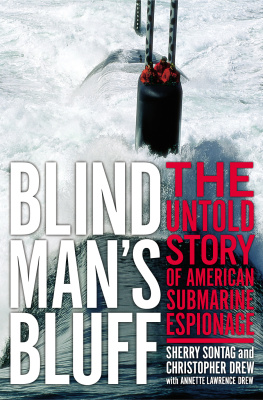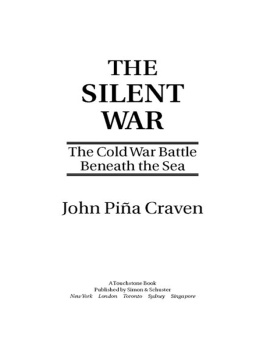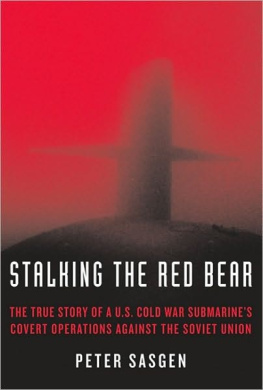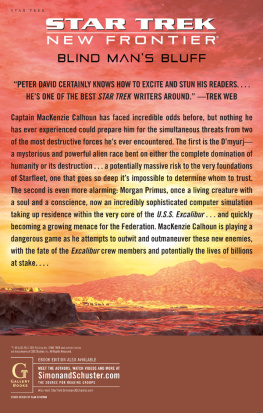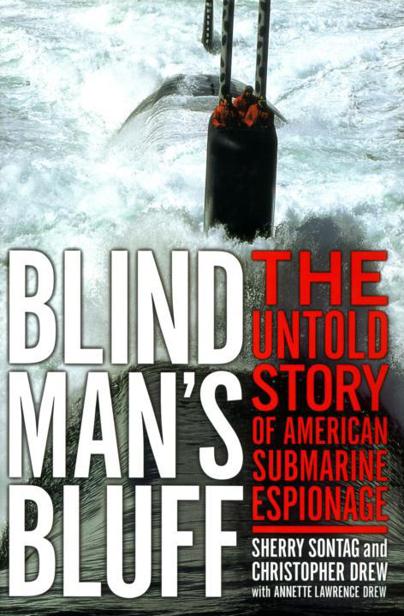
BLIND MAN'S BLUFF
Dedication
TO THE MEN WHO LIVED THESE TALES, AND ESPECIALLY TO THOSE WHO SHARED THEM WITH US.
"After all, submarining has always been a game of blind man's bluff. "
A top submarine admiral

Lyrics from "The Ballad of Whitey Mack," an ode to a submarine captain by Tommy Cox, submariner and spook
Prologue
There was something about Commander Charles R. MacVean that had a way of inspiring legend. It wasn't the way he looked: tall, a little chunky and in his late thirties already crowned by a thatch of thinning gray hair. It was his sense of humor and his humanity. This was a man who could stand beneath a hatch after being doused with a column of water, deadpan and still chewing his dripping pipe. This was also the man who had just led the nuclear attack submarine USS Seawolf on one of the most dangerous operations of the cold war. She had slipped inside a Soviet sea and eavesdropped on the enemy in a way most other subs could never dare. Now, finally home, MacVean was enjoying the chance to get some sleep.The phone rang. MacVean snapped awake and checked the time, 2:00 A.M. The call was from Navy headquarters in Washington, D.C., and the voice on the other end of the line belonged to a somewhat embarrassed and confused Navy officer."There's a sailor from your ship at a bar called the Horse and Cow," he said, "and he's trying to call the president to tell him what a great job you did and how great you are. Could you go get him out of the phone booth?"MacVean knew just where the Horse and Cow was, as did all of his men. This was the submariners' haunt in Vallejo, California, a darkened place decorated with pieces of just about every sub that ever steamed through the Pacific toward the Soviet Union, a place where men built themselves up for what they would face out at sea and where they celebrated survival when they made it home. The commander rousted his chief of the boat, and together they drove over to the spot isolated along a highway service road and pulled into a park ing lot that was more potholes than pavement. Sure enough, they found a somewhat inebriated member of Seawolfs crew, lodged in a phone booth, still trying to talk his way past a White House operator. MacVean got his man off the phone, then bought him a beer. MacVean was that kind of captain. Besides, he knew the guy deserved one. They all did.This happened in the mid-1970s, but it could have occurred at almost any time during the cold war. MacVean and his men were, after all, part of an intelligence operation unlike any other in the annals of American history. For more than four decades, under the cover of classifications even higher than top-secret, the United States sent tens of thousands of men in cramped steel cylinders on spy missions off the rugged coasts of the Soviet Union. There, the job was to stay hidden, to gather information about the enemy's intentions and its abilities to wage war at sea. By their very nature, submarines were perfect for this task, designed to lurk nearly silent and unseen beneath the waves. They quickly became one of America's most crucial spy vehicles.No other intelligence operation has embraced so many generations of a single military force, no other has consistently placed so many Americans at risk. As many as 140 men on each sub, several subs at a time, nearly every man who ever served on a U.S. attack submarine was sent to watch Soviet harbors and shipyards, monitor Soviet missile tests, or shadow Soviet subs. Several boats, such as Seawolf, were specially equipped to tap cables or retrieve pieces of Soviet weapons that had been fired in tests and had fallen to the bottom of the sea. No one was involved who didn't volunteer.These submarine spies stood as lonely sentries on the frontlines of a war that was waged fiercely by both sides. Only in this war the most important weapons weren't torpedoes, but cameras, advanced sonar, and an array of complicated eavesdropping equipment. And while these men rode some of the most technologically daunting craft ever built, their goals were deceptively simple: "Know thy enemy," learn enough to forestall a surprise attack, to prevent at almost any cost a repeat of Pearl Harbor in a nuclear age.In silence and stealth, but most importantly in secrecy, attack subs carried out as many as two thousand spy missions as they kept track of Soviet submarines. Most crucial was tracking the boomers-Soviet subs longer than football fields that carried up to twenty ballistic missiles. These missiles could launch up to ten nuclear warheads each, and a single missile sub could create a firestorm greater than the combined power of all the bombs dropped in World War II. That these arsenals were portable and hidden at sea made them much less vulnerable and much more dangerous than bombs designed to be sent on planes or launched from fixed spots on land.There was only one good way to counter missiles carried on submarines, and that was with other subs. It was of little wonder then that learning about these missile subs and trailing them became the single biggest priority of the U.S. Navy. This was worth almost any risk, this was the reason submariners were sent out again and again. This is what motivated the decades-long game of "blind man's bluff." It was in this quest to track Soviet advances and Soviet subs that men traded their homes, the sun, and any illusion of privacy for the crowded, windowless craft and felt their way through the exotic ocean terrains that cover two-thirds of the globe. They traversed down to the Mediterranean, up to the icy hazards of the Arctic, and often straight into Soviet territorial waters. They lived with barely a view of the oceans and seas they traveled through, save for what they could glimpse through the glass of a periscope or imagine from electronic flickers playing upon sonar screens and oceans of static scratching through sonarmen's headsets.In the cold and dark, submariners faced hazards worse than those that have traditionally confronted seafaring men, for the ocean pressures could easily crush steel hulls should they go too deep. Over the years, such catastrophes struck submarines from both sides. Just as threatening were the Soviets themselves, who were determined to stop these American spies and fought back as best they could, sometimes with depth charges, sometimes by enlisting American military and intelligence staffers to spy for them. The risk in all of this became increasingly obvious as Soviet and U.S. subs engaged in frantic chases, as misjudgments led to collisions, as U.S. submarines were detected in Soviet waters.To the Soviets, American submariners were more than an enemy; they were ever-present pests. To other Americans, they were simply the anonymous men of the Silent Service. This book is their story, one that has gone unspoken and unheralded, until now. This is one of the last, great, untold stories of the cold war.At its heart, the motivation for the submariners' hunt-to prevent an adversary from launching a wave of death from the oceans seems almost timeless. In the early sixteenth century, Leonardo da Vinci sketched out a design for a proto-submarine but wrote in his notebook that he'd never reveal how one would run underwater because he feared the evil nature of men who would use them as a means of destruction at the bottom of the sea."Still, it was that very potential for surprise devastation that spurred on inventors who followed. During the Civil War, they tried to build bubble-shaped subs and then others that looked like short cigars, all to stick mines on the bottoms of enemy ships. The subs were powered by hand cranks and treadmills, and most of the men killed by these new weapons were members of their own tiny crews. Still, there was terror in the sheer attempt, and it was only a few years after the Civil War that Jules Verne, in his novel Twenty Thousand Leagues Under the Sea, depicted the submarine as a sea monster ramming ships. That his creation was powered with electricity was prophetic. The Holland-the U.S. Navy's first working submarine-ran on electric batteries when submerged, a gas engine on the surface. Purchased on April 11, 1900, she was only fifty feet long and held a crew of six.Submarine technology progressed so rapidly that less than a generation later Germany's diesel-powered submarines were terrorizing Allied ships during World War I. It was one of these German "U - boats" that shattered U.S. neutrality by sinking the British passenger liner Lusitania, after she sailed from New York in 1915. By the time the United States entered the war two years later, German U-boats had destroyed several hundred ships.By World War II, submarines had hecorne so powerful they were able to go after armed surface convoys, and they had become a decisive factor. Germany sent its subs out in "Wolf Packs" that could converge for a kill, a tactic so lethal that the United States seized on it to regain control of the Pacific after Pearl Harbor. The impact on Japanese troop ships, tankers, and freighters was devastating, but it came with great cost. The United States lost fifty-two subs and thirty-five hundred men.It is these World War II images of subs shooting torpedoes, of men trapped sweating within cramped steel cylinders as Japanese sonar pings rang through their hulls and depth charges fell around them, that remain most vivid. But there was something else going on in those days as well, the beginning of a tentative courtship between submariners and spies. A few times, subs put up simple antennas to intercept Japa nese radio messages and about a dozen submarines were sent to conduct periscope beach-reconnaissance to prepare for troop landings. These experiments piqued the interest of intelligence officials and showed that submarines could have a new mission once the cold war began. Diesel subs were the first to give it a try. Then came the creation of submarines with nearly endless power and unlimited stealth-boats powered by nuclear reactors that could remain submerged for months at a time. With these, U.S. submariners would grasp the definitive edge in the cold war under the seas.The details of all of this have been closely held by top admirals and captains within the Navy, who typically disclosed these operations only to the president, his top military and intelligence advisers, and a few congressmen who only rarely pressed for details. But ultimately, control of any mission rested in the hands of young submarine captains, who were usually about thirty-five years old and under orders to maintain complete radio silence. These men were encouraged to take risks, and some slipped right into Soviet harbors or into the middle of Soviet naval exercises to bring home the best information. Still, their prime directive remained: avoid detection and keep the Soviets unaware of just how closely they were being watched. That necessity, more than anything, was also what impelled the staunch secrecy surrounding these missions.Still, every now and then, even a few insiders fretted. Were these missions too provocative, too dangerous? Could one failed mission or one terrible accident coax the two superpowers to the brink? Could these spy missions inadvertently spark the very war they were designed to prevent? As long as these submarine operations remained secret, the Navy was rarely faced with these questions.It was only through several years of interviews that we were able to piece together events so long hidden, and then only with great effort and persistence. We contacted hundreds of submariners. Some responded by telephoning the Navy's investigators, and some simply declined to talk. Many others, however, agreed to meet in interviews that took place face to face throughout the United States. At times, the Naval Investigative Service visited or called these men, intoning grim reminders of secrecy oaths and legal obligations. But the details mounted nonetheless, as submarine officers, enlisted men, political figures, and intelligence officials decided the time had come to tell their stories. For the submariners especially, talking offered release. Most had never given the details of their months-long absences to their parents, wives, children, or best friends. They could never come home and just unload after hard months at work. They needed to speak to someone who understood, to find some long-overdue recognition.And so we write about them, and for them. The people, their names, and the events in this book are real, and the tales told in each chapter are rendered as faithfully and scrupulously as possible based on extensive interviews and the few documents that have been released. Conversations are related here, as they were repeated to us by people who were involved or who were there to hear the words as they were spoken. Still, not all of the people we describe in this book talked to us. Instead, they are here because they were at the heart of some of the most critical operations of the cold war. In most cases, we had to promise our sources that they would be protected, that we would not attribute information to them or disclose even that we had met with them.Most of the stories in Blind Man's Bluff have never been told publicly, and none have ever been told in this level of detail. So instead of repeatedly pointing out each time we offer new information, we have decided to flag, either in the text or in footnotes, only the details that were already available. The rest of this book is a first, even for many of the men who served full careers in the submarine service but were given only the information that the Navy deemed they had a need to know.This is a book about submarines, espionage, and geopolitics, but it is also a book about people: the poetry-spouting deep-sea scientist who was asked to conjure up ways of recovering nuclear missiles from the ocean floor; the Naval Intelligence officer whose childhood memories led him to conjure up the idea of tapping Soviet underwater communications cables; a cowboy sub commander who couldn't resist sneaking up to within feet of Soviet subs; the men whose sub was held underwater with barely enough air to keep them alive as Soviet ships above rained down explosives. We also present new information that may solve the mystery of what happened to the USS Scorpion, an American spy sub that sank, all hands lost, thirty years ago.Most books about submarines focus on one man, perhaps the single most influential officer in the modern Navy and the father of the nuclear submarine: Admiral Hyman G. Rickover. But even Rickover had to look on as other men drove his boats and led these missions. So this is not the story of one man, but the story of a force of men who served over decades. We trace their efforts through the decades in three phases: from the early fumblings, through the greatest sea hunts, to the times when technology and imagination allowed the sub force to reach straight into the Soviets' minds. And like so many great epics, this one does not end. American submariners are still being sent to keep an eye on Russia, as well as to peer at other hot spots around the globe. The stories here are not just a look in microcosm at the nation's mammoth espionage efforts. They are a lesson in how far governments will go to learn one another", secrets, no matter where they stand in time or place.
Next page


